High-quality backlinks are one of the most important SEO factors.
But without knowing how many backlinks are pointing to your site and where they are coming from, it is hard to execute an effective link-building strategy.
If you have ever wondered, how do I find out who links to my website — this guide is for you.
I will show you the best tools and methods you can use to see who is linking to your site or any other site on the web.
How to Find Who Links to Your Website
Use any of these methods to find out who links to your website.
- Google Search Console Links Report
- Bing Webmaster Tools Backlinks Report
- SEMRush Backlink Analysis Tool
- SE Rankings' Backlink Checker
1. Google Search Console Links Report
The first free option you can use to see who is linking to your website is Google Search Console.
GSC provides a wide array of helpful tools to monitor and manage your website's performance within the world's most popular search engine. One of these tools is the Links Report, which gives a detailed analysis of all the backlinks currently pointing to your website.
Once your search console account is set up, you can visit the links report for your web property by clicking LINKS from the left menu.
On the report, you'll find a list of your top linked pages with the number of sites linking to each page.
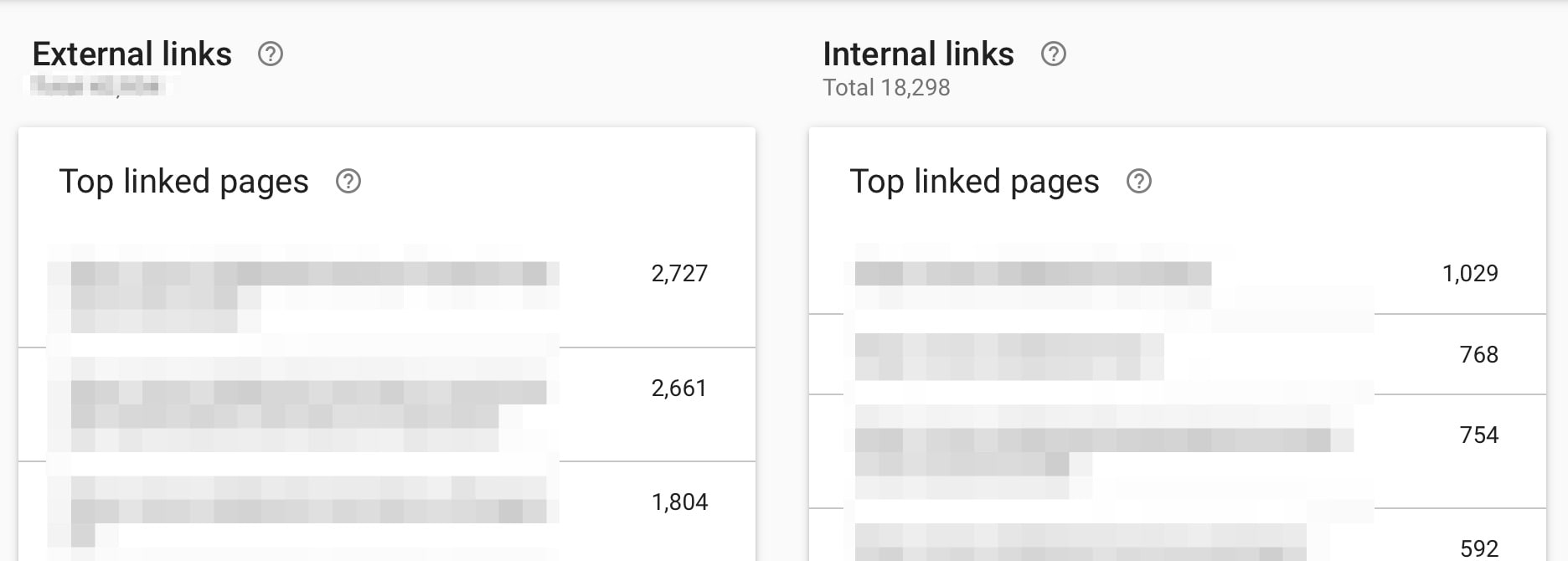
Next is a list of the top sites linking to your website. When you click on a site on the list, you can see which of your pages that domain is linking to.
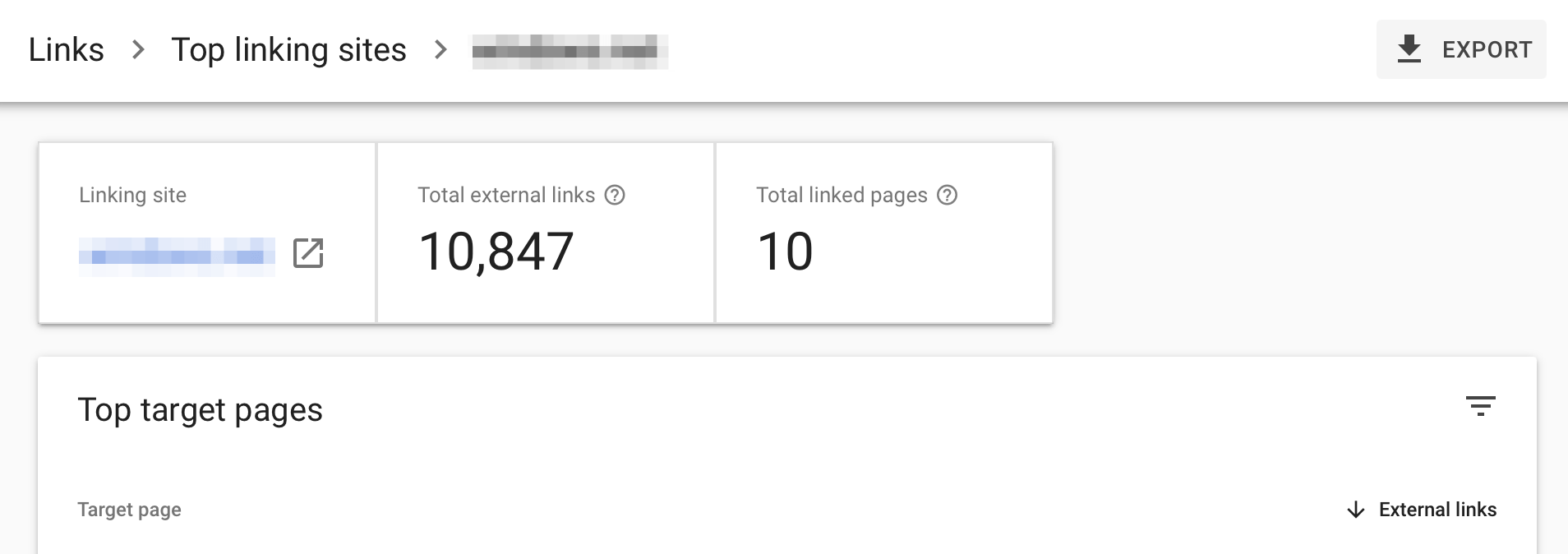
Finally, you'll find a list of top linking text that shows which anchor text websites are using when linking back to your website.
The links report also has a list of all the internal links on your site. This list can come in handy when making sure that you are building out a solid internal linking structure to help search engines crawl and understand your website.
2. Bing Webmaster Tools Backlinks Report
The next option for finding out who links to your website is Bing Webmaster Tools. The Microsoft equivalent to Google Search Console is used to monitor and manage your website’s performance within the Bing search engine.
Like Search Console, Webmaster Tools has a backlink report that provides details about all the websites linking back to yours. You can find the report under SEO in the left menu.
At the top of the report, you can see the total number of referring domains, the total number of referring pages, and the total number of different anchor texts used.
The Domains section of the Backlinks Report shows you a list of all the unique domains that are linking to your site, as well as the number of backlinks coming from each domain.
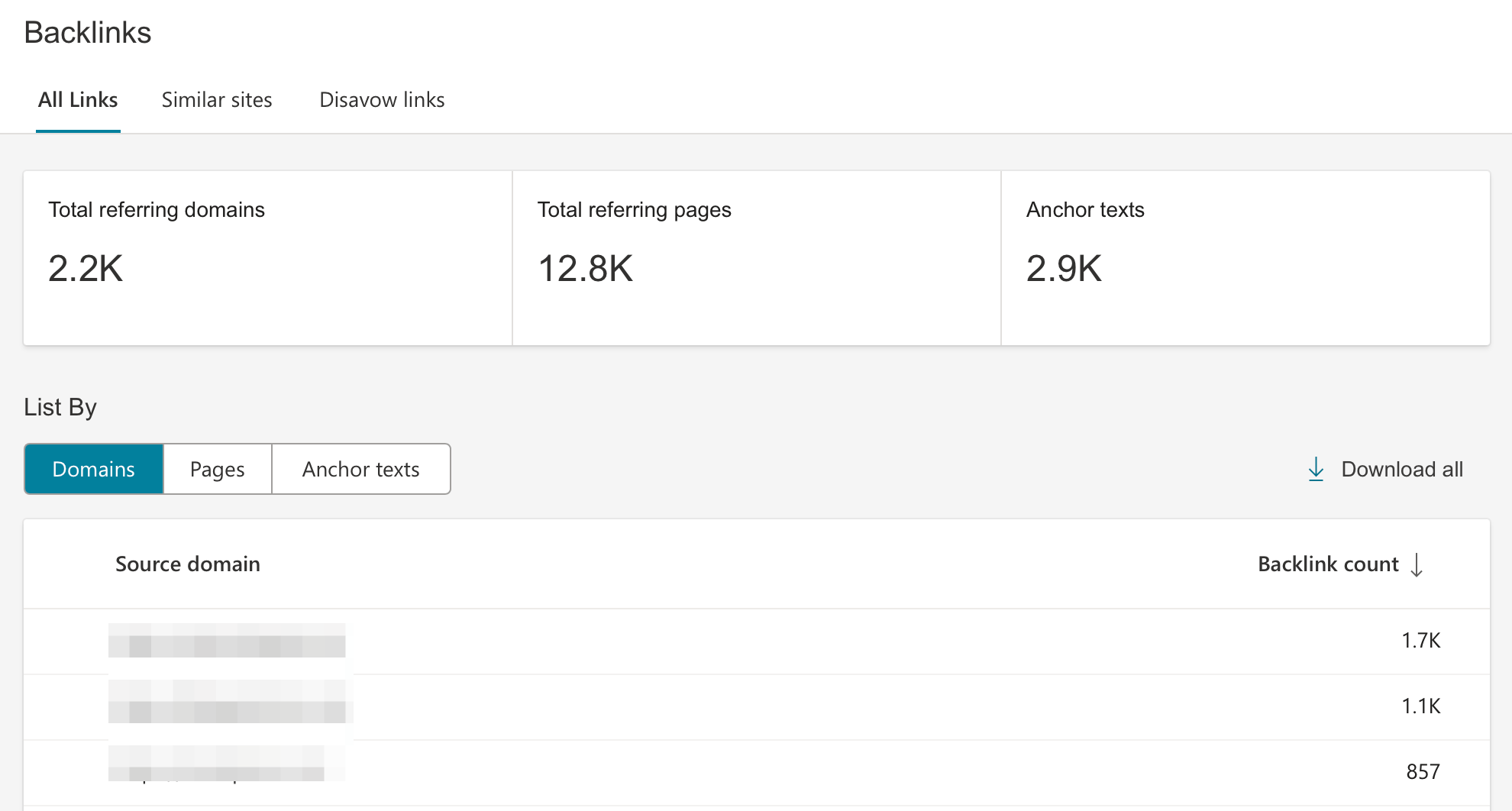
When you click on a domain, you can see which specific pages are linking to your website and which of your URLs the links are pointing to. You can also see the exact anchor text being used for each link.
3. SEMRush Backlink Analysis Tool
SEMRush provides a comprehensive suite of digital marketing solutions including a Backlink Analysis tool that you can use to check the links for your site or any other on the web.
When you enter your website, you are taken to an Overview tab where you can see your website’s authority score, total referring domains, and the total number of backlinks.
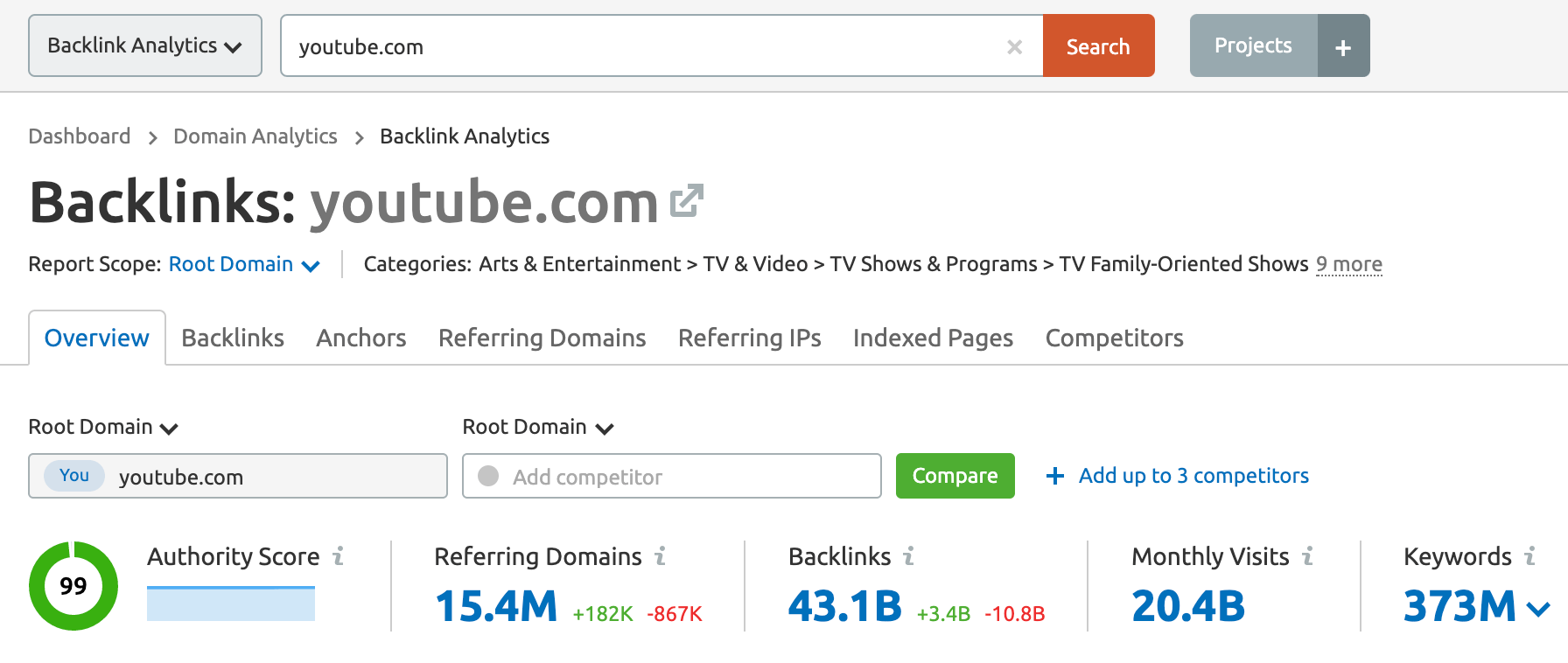
For a more detailed analysis, go to the Referring Domains tab. Here you will find a list of all the different websites linking back to you.
The table displays each website’s authority score, the total number of backlinks coming from the site as well as its IP address.
When you click on the view button next to each website’s backlink total you can get more insight into the links pointing to your site. By doing so you will see the specific URLs linking to your site, which of your pages the links are going to, and what anchor text is being used.
It will also show if the link is dofollow or nofollow and when SEMRush first detected the link.
SEMRush provides users access to the Backlink Analysis tool for free. However, with the free version, the amount of data you are able to view is limited.
When you visit the Referring Domains report for your website, you are only able to see the top 10 results. For full access to all the backlink data, you need to sign up for a paid plan.
4. SE Ranking’s Backlink Checker
SE Ranking provides a robust set of SEO tools, including the Backlink Checker, which can help you perform a detailed analysis of backlink profiles—whether yours or your competitor’s.
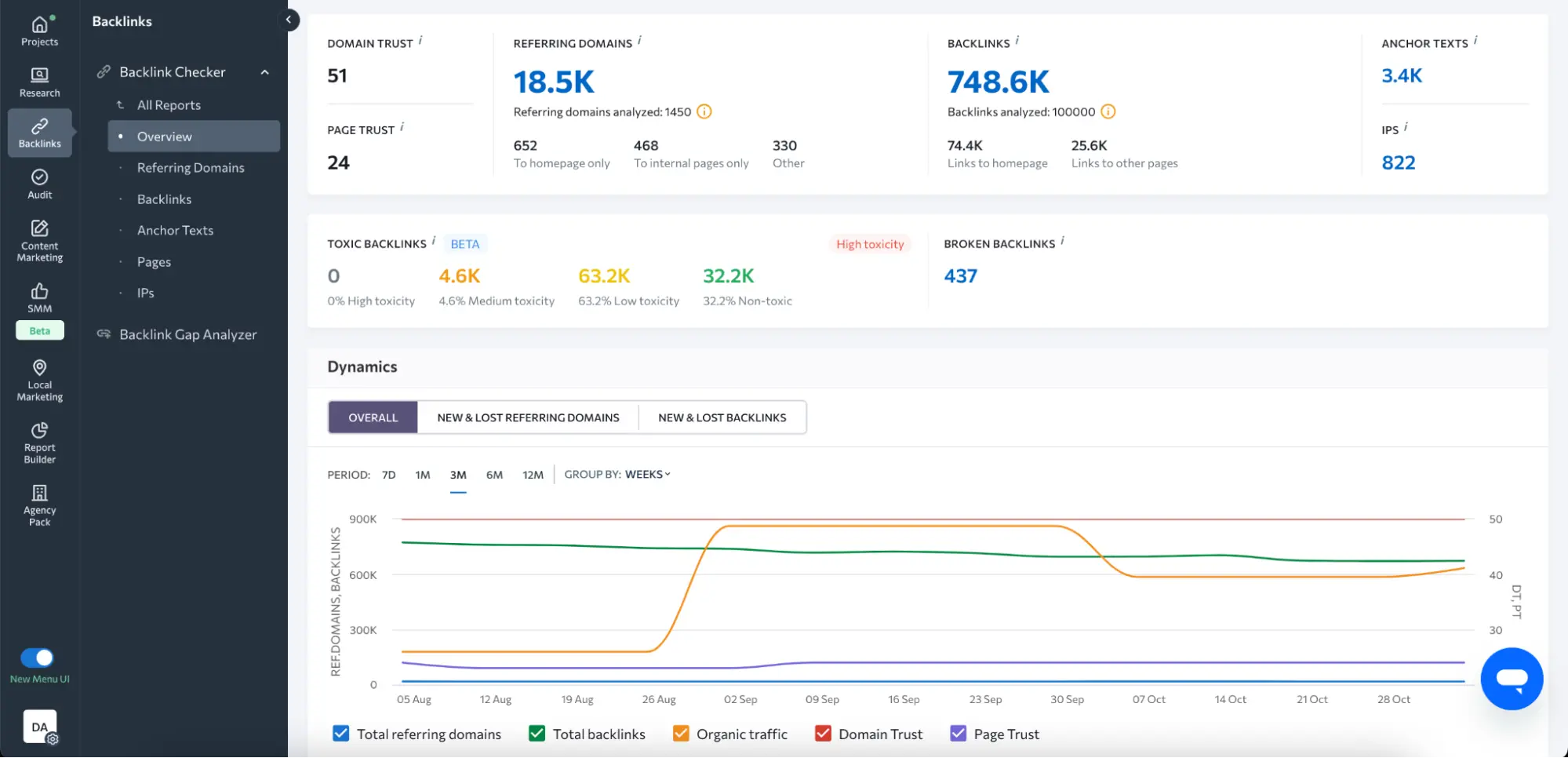
Input a website’s URL to access the Overview section. There, you’ll discover details such as:
- The total count of referring domains and backlinks
- The growth rate of backlinks and referring domains over time
- The percentage of links directed to the homepage versus internal pages
- The anchor texts used for backlinks
- The number and percentage of referring domains in each Domain Trust range
You can run up to 5 free backlink checks daily and gain high-level backlink insights. You can explore its full capabilities by signing up for a free 14-day trial, which gives access to SE Ranking’s other features and tools.
To find pages that link to a specific URL input its URL at the beginning of the analysis and select the Exact URL option.
Alternatively, head to the Pages tab to view backlinks for all individual pages within the analyzed domain. This section displays the list of all backlinks (and referring domains) pointing to each page, along with key SEO metrics like Domain Trust, Page, Trust, toxicity score, total traffic, link type (dofollow/nofollow), and so on.
How to Find Links to a Specific Page
If you want to see the links to a particular page on your website, you can use the tools referenced above.
With the Google Search Console Links Report, you can find links to a specific page by clicking on a URL from the Top Linked Pages Report. You’ll be taken to a list of all the domains linking to that page and can see how many total links are coming from that particular site.
When you click on that domain, you are taken to a list of all the specific URLs that contain links back to your target page.
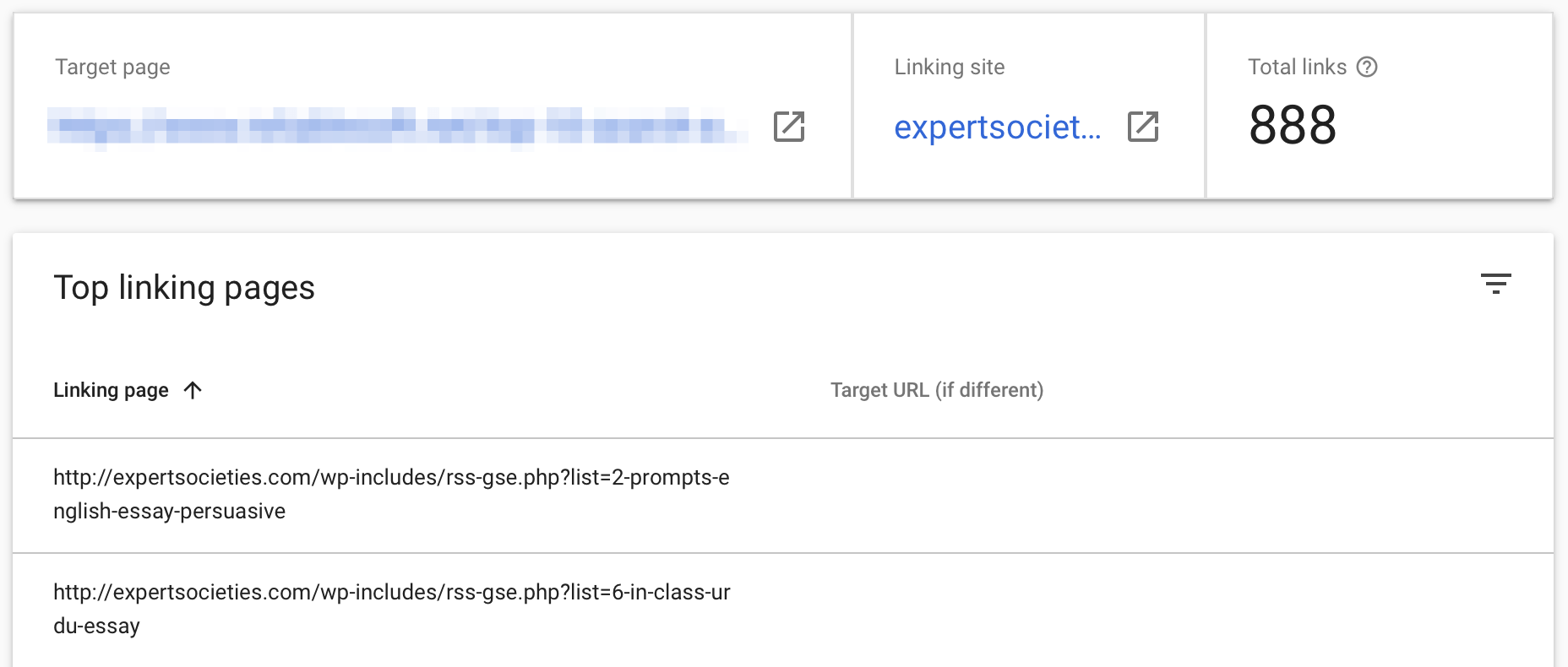
With the Bing Webmaster Tools Backlinks Report, you can see the links to a specific page by visiting either the Domains or Pages section of the report.
This will show you a list of the domains or specific pages linking to your website depending on what section you are using. By drilling into both sections you can see which of your specific pages are being linked to.
You can export the data to a spreadsheet and then search for a specific URL to quickly scan all the links pointing to that particular page.
Using the SEMRush Backlink Analysis tool you can search for a specific URL directly to quickly see how many backlinks the page has and where they are coming from.
When you search for a specific URL the report is in the same format as when searching for a domain, only it shows results exclusively for that page, not the entire website.
If you click on the backlinks tab, you’ll find a list of each backlink pointing to that specific page. This includes what exact URL the link is coming from and what anchor text the link is using.
How to Find Sites That Link to Any Site?
Knowing how to find out who is linking to your competitor's websites is just as useful as knowing who is linking to yours.
While you can’t create a Google Search Console account to monitor your competitors, there are several tools you can use to quickly check the backlinks to any website.
Use any of these methods to find out who links to any site.
- Bing Webmaster Tools Similar Sites Report
- Ahrefs Free Backlink Checker
1. Bing Webmaster Tools Similar Sites Report
With the Bing Webmaster Tools Similar Sites report, you can compare multiple websites side by side to quickly analyze their backlink profile. You can find the report by clicking SEO > Backlinks from the left menu and then selecting the 'Similar Sites' tab.
When you first open the report, your website will automatically be selected as the first site to be used in the comparison. You’ll have the option to add two more sites to compare up to three (including your site) simultaneously.
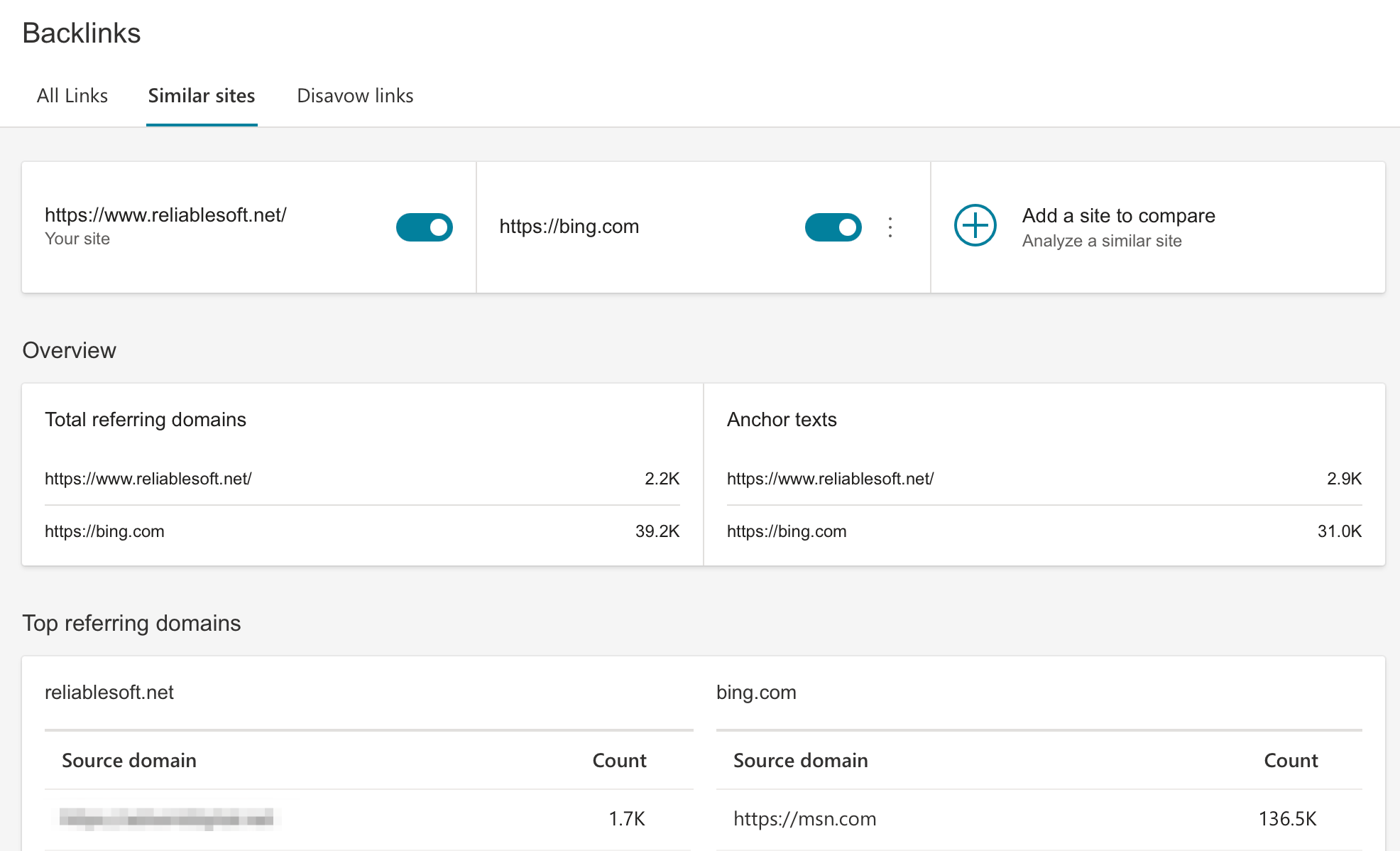
The report shows the total number of referring domains and the total number of different anchor texts for each website. There is also a complete list of all the referring domains for each website.
When you select a referring domain, you are taken to a sub-report detailing every unique URL linking to the target website along with the specific page being linked to.
2. Ahrefs Free Backlink Checker
Arguably the most effective tool for checking the backlinks to any website is the free Ahrefs Backlink Checker.
With over 25 trillion known backlinks and 170 million unique domains, you can be sure you are receiving accurate data when you perform backlink analysis using this tool.
When you enter a website into the checker you receive a report packed with tons of useful info.
The overview includes the website's domain rating, the total number of backlinks, the total number of referring domains, and what percentage of the links and domains are dofollow.
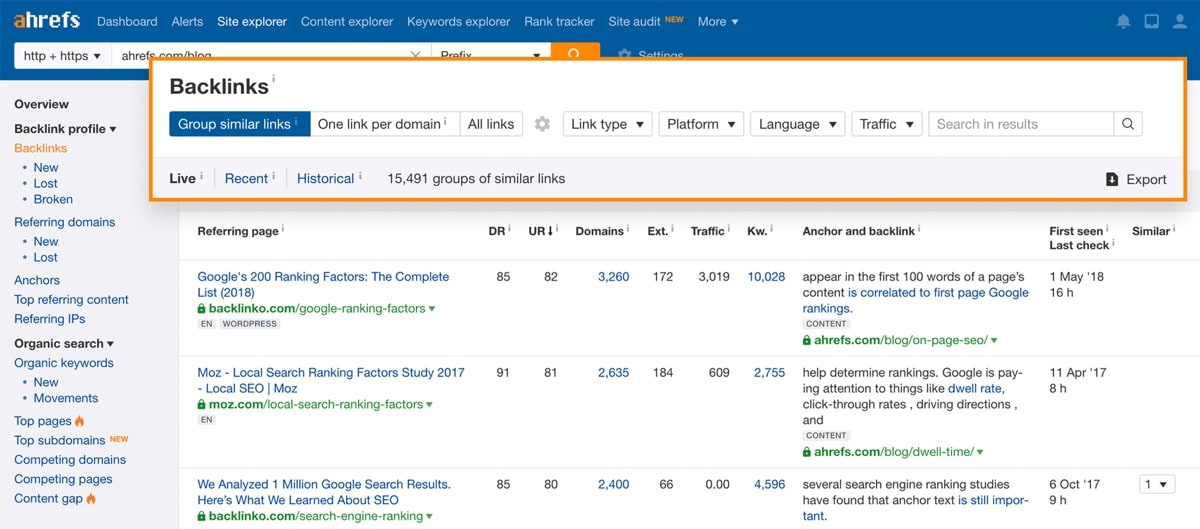
Further down the report is a list of the backlinks pointing to the site. For each link, you’ll see the referring page, the Domain Rating and URL rating for the referring page, the anchor text of the backlink, and whether the link is dofollow or nofollow.
You can toggle the backlinks chart to instead show the top anchor texts used for links pointing to the target website or the top pages receiving links.
You are also able to search and analyze links for a specific URL instead of the domain as a whole.
The free version of Ahrefs Backlink Checker only shows the top 100 backlinks for each URL that you search. If you want to unlock the full power of the platform, you need to signup for a paid plan.
It can be well worth the cost as Ahrefs boasts one of the most comprehensive suites of SEO tools on the market today. Ahrefs offers new users a 7-day trial for just $7 to test the platform out for themselves before committing to a paid plan.
Why Are Links Important in SEO?
Links are important in SEO because they are perceived as a ‘vote of trust’ from one website to another.
When a site links to another, Google takes it as a sign that the linking site finds the other site valuable and of high enough quality to make it worth linking to.
Google then takes these signals into account when ranking different pages in its index.

While links are important, not all links have the same level of value. There are certain factors that enable some links to have a much bigger impact on SEO than others.
Authority of the referring domain
Each website’s authority can essentially be measured by a numerical value. Some SEO tools call this metric Domain Authority, others Domain Score or Domain Rating but the concept is the same.
The more authoritative a website is, the higher its score. This score plays a role in SEO as Google is more likely to rank a page from a more authoritative site.
It also plays an important factor in link building as links from authoritative sites are much better at improving SEO rankings than links from small non-authoritative sites.
When a website links to another website it passes on some of that authority to the site it is linking to. Naturally, getting links from sites with more authority are much more valuable because they are the ones that can lead to results.
Dofollow vs nofollow links
The inherent value of backlinks comes from their ability to pass Domain Authority and PageRank onto the target page.
Whether or not a link is able to pass this “link juice” on to the target site depends on if the link is a dofollow or nofollow link.
Nofollow links are backlinks that have the rel=”nofollow” attribute. This HTML tag tells search engines to ignore that link and to not pass page rank from the referring site to the target site.
Dofollow links are those that do not have the nofollow attribute applied.
Nofollow links can not affect SEO rankings but they are still useful. If you get an article published in a major publication like Forbes, the links will be nofollow but the links can still lead to referral traffic. It is also good for branding to have your businesses mentioned by an industry leader.
Anchor text
Anchor text is the user-facing text that is the visible and clickable part of a link.
It is important to SEO as it gives a signal to search engines and users about the page being linked to.
For example, the following link — What you need to know about anchor text, makes it clear that the page being linked to is about anchor text.
Anchor text can tell Google what keywords a page should rank for, so links like the one above that contain target keywords can be helpful in boosting SEO rankings.
That said, it is important not to over-optimize the anchor text for links as Google may penalize your site.
You should only use anchor keywords that are actually relevant to the page. It is also good practice to have a backlink profile with a mixture of all types of anchor texts (branded, domain name, naked URL, partial match, generic, etc.)
This will make your link profile look natural and will keep you from being penalized.
What to do Next?
Analyze your Link Profile and Remove Potentially Dangerous Links
Bad links can hurt your website the same way high-quality links can boost your website.
As such, it is important to continually monitor your link profile to ensure it is free of these dangerous links.
Examples of bad links that can hurt your site include:
- Excessive random nofollow links
- Links that appear to be from a paid link-building scheme
- Guest post links with over-optimized anchor text
- Public blog network links
- Forum links
- Blog comment links
We’ve put together a detailed guide on how to find bad links using tools like Google Search Console and SEMRush.
Once you have curated a list of unwanted links, the first step you should take to have them removed is to contact the webmasters of the sites producing the unwanted links and ask them to remove the links or add a nofollow tag.
In most cases, this is difficult to achieve as getting in contact with the owners of some sites can be challenging. It is still worth trying however as it is the simplest way to remove unwanted links.
You can always remove the pages receiving the bad links but this is generally not a good solution especially if some of your important pages are getting the bad links.
Your other option is to use the Google disavow tool. The tool is essentially a feature that lets you upload a file with a list of links you don’t want Google to consider.
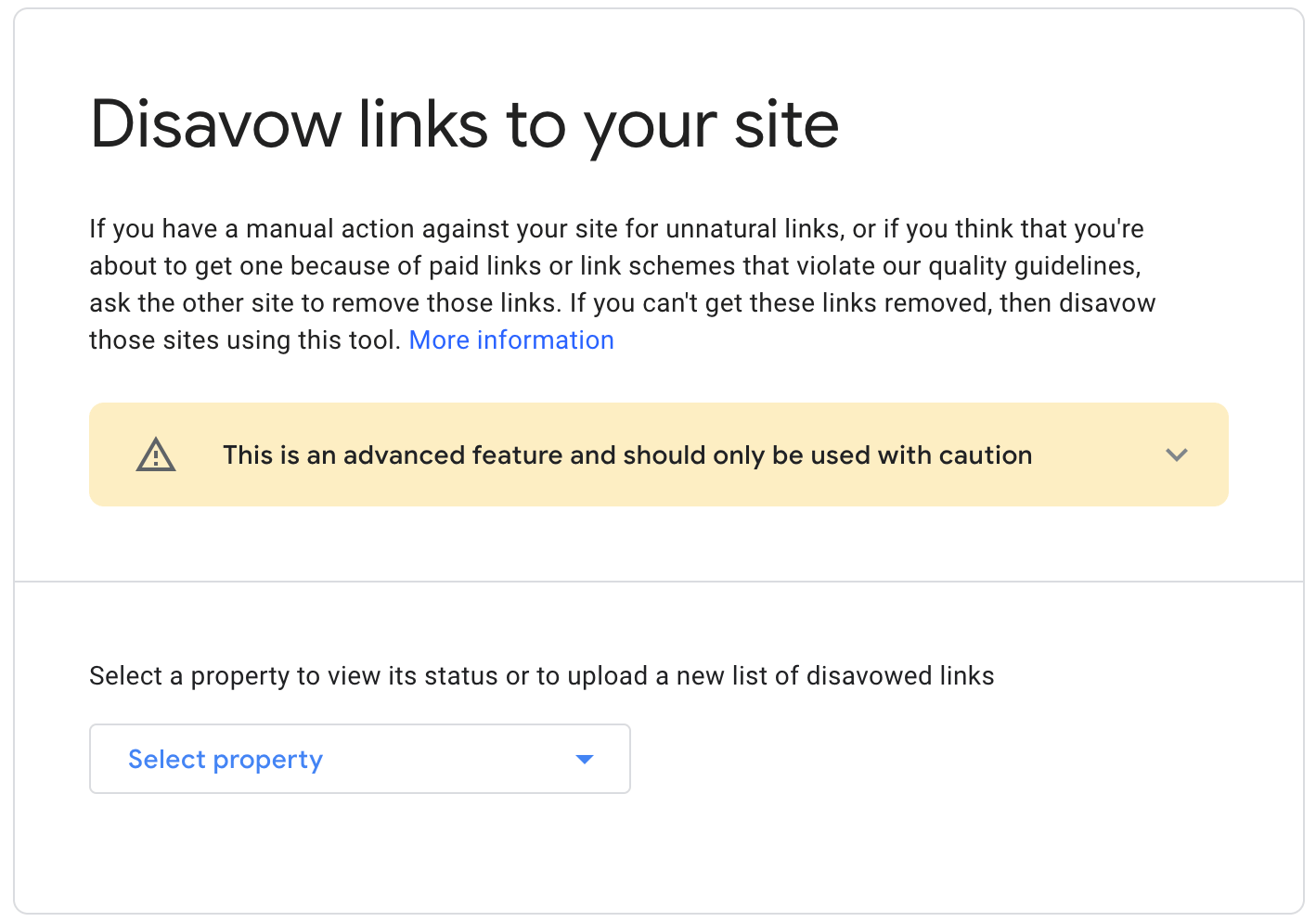
It’s important to be careful when using this tool as Google themselves state that it can do more harm than good if it’s not used correctly.
If you decide to use the tool, you need to prepare the file in the proper format before uploading it to Google. For this, you can either prepare the file manually or use a tool like SEMRush.
Bing Webmaster Tools also has a disavow tool you can use to submit pages and URLs that contain links to your site that you feel are low-quality or unnatural.
Analyze your Competitor’s Link Profile and Identify Link Opportunities
Websites that link to competitors with content similar to your own are a great target for gaining new links.
These sites have proven that they are willing to link to certain types of content so if you are able to create quality pages similar to your competitors, you are a prime option for receiving links as well.
Take advantage of one of the tools previously mentioned (SEMRush, Ahrefs, Alexa) to scan your competitors’ link profiles to find backlink opportunities.
Look for high-authority referring domains giving out plenty of dofollow links. You also take note of the types of pages receiving the links so you can create similar linkable content.
Build More Links to Your Most Important Pages
Once you have identified profitable link opportunities, you’ll want to launch link building campaigns to build links to your most important pages.
There are plenty of link building strategies you can employ. Two tactics that can be particularly effective for building links to your most important pages are guest posting and outreach campaigns.
Guest posting
Guest posting remains one of the most effective link building methods as it allows you to provide something of value to a referring website for no cost to them.
When running your guest posting campaigns, be sure to reach out to websites that allow you to link back to your website within the post. You’ll also want to ensure that any links you get are dofollow.
This will give you high-quality links to your most important pages that can help boost your SEO rankings.
Outreach campaigns
Outreach campaigns are a great way to build high-quality backlinks at scale. With this technique, you compile a list of high-authority websites that are at least somewhat related to your business’ niche and contact them asking for a link to your page.
Another way to make your outreach campaigns more effective is to use the skyscraper technique. This is where you find a competitor’s page that is similar to yours and is receiving a lot of high-quality links.
You enhance your page so that it is notably better and then reach out to those referring sites asking for them to link to your higher-quality content instead.
Key Learnings
Backlinks are an important part of Off-Page SEO because they act as a vote of confidence from one website to another. Google takes these votes of trust as a signal of value and quality and uses them when ranking pages.
Not all backlinks have the same effect on SEO. Links from websites with a high domain authority are more valuable than those from sites with low authority.
This is because some of a website’s authority is passed on to the other site when linking to them. Links from low-authority sites simply don’t do much in boosting the target page’s authority.
In the same regard, links with a nofollow tag are less valuable from an SEO perspective as they tell Google not to pass page rank to the target page.
Bad links like those from spammy sites or paid link building schemes can hurt your site just as much as good links help your site.
There are several free tools that can help you see the links to your site.
You can use the Links reports within your Google Search Console and Bing Webmaster Tools accounts to quickly see all the referring domains linking to your site, the specific URLs where the links are coming from, and which of your pages are being linked to.
There are also several more robust tools that you can use to check the links for any website across the web. Popular options include SEMRush’s Backlink Analysis tool, Ahrefs’ Backlink Checker, and Alexa’s Competitor Backlink Checker.
With these powerful solutions, you can quickly see what kind of sites are linking to your competitors to find backlinks opportunities that could be profitable for your business.
Once you have identified link opportunities you can launch different link-building campaigns to gain high-quality links that can help boost your website’s SEO performance.



